Panasonic ST50M, ST50P, ST50T, ST50K, ST50D User Manual

Information on Disposal in other Countries outside the European Union
This symbol is only valid in the European Union. If you wish to discard this product, please contact your local authorities or dealer and ask for the correct method of disposal.
[India Only]
For the purpose of recycling to facilitate effective utilization of resources, please return this product to a nearby authorized collection center, registered dismantler or recycler, or Panasonic service center
when disposing of this product.
Please see the Panasonic website for further information on collection centers, etc. http://www.panasonic.co.in/wps/portal/home
Customer’s Record
The model number and serial number of this product may be found on its rear panel. You should note this serial number in the space provided below and retain this book, plus your purchase receipt, as a permanent record of your purchase to aid in identification in the event of theft or loss, and for Warranty Service purposes.
Model Number |
Serial Number |
M0312-0
Web Site: http://panasonic.net
© Panasonic Corporation 2012 |
Printed in Thailand |

ST50D series
ST50K series
ST50M series
ST50P series
ST50T series
Operating Instructions
Plasma Television
Thank you for purchasing this Panasonic product.
Please read these instructions carefully before operating this product and retain them for future reference.
The images shown in this manual are for illustrative purposes only.
English
TQB4TC0290
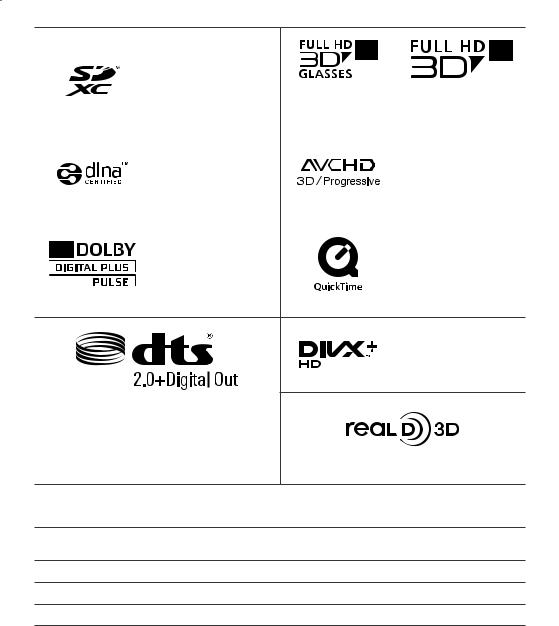
SDXC Logo is a trademark |
|
|
|
of SD-3C, LLC. |
|
|
|
|
“Full HD 3D Glasses™” logo and “Full HD 3D Glasses™” |
||
|
word are trademark of Full HD 3D Glasses Initiative |
||
|
|
|
|
DLNA®, the DLNA Logo and |
|
|
“AVCHD”, “AVCHD 3D” and |
DLNA CERTIFIED™ are |
|
|
|
|
|
“AVCHD Progressive” are |
|
trademarks, service marks, |
|
|
|
|
|
trademarks of Panasonic |
|
or certification marks of |
|
|
|
|
|
Corporation and Sony |
|
the Digital Living Network |
|
|
|
|
|
Corporation. |
|
Alliance. |
|
|
|
|
|
|
|
|
|
|
|
Manufactured under license |
|
|
QuickTime and the |
|
|
||
|
|
QuickTime logo are |
|
from Dolby Laboratories. |
|
|
|
|
|
trademarks or registered |
|
Dolby and the double-D |
|
|
|
|
|
trademarks of Apple |
|
symbol are trademarks of |
|
|
|
|
|
Inc., used under license |
|
Dolby Laboratories. |
|
|
|
|
|
therefrom. |
|
|
|
|
|
DivX®, DivX Certified®, DivX Plus® HD and associated logos are trademarks of Rovi Corporation or its subsidiaries and are used under license.
Manufactured under license under U.S. Patent Nos: |
|
|
5,956,674; 5,974,380; 6,487,535 & other U.S. and |
|
|
worldwide patents issued & pending. DTS, the Symbol, |
|
|
& DTS and the Symbol together are registered |
|
|
trademarks & DTS 2.0+Digital Out is a trademark of |
|
|
DTS, Inc. Product includes software. © DTS, Inc. All |
“RealD 3D” is a trademark of RealD. |
|
Rights Reserved. |
||
|
The Bluetooth® word mark and logos are registered trademarks owned by the Bluetooth SIG, Inc. and any use of such marks by Panasonic Corporation is under license. Other trademarks and trade names are those of their respective owners.
HDMI, the HDMI Logo, and High-Definition Multimedia Interface are trademarks or registered trademarks of HDMI Licensing LLC in the United States and other countries.
Windows is a registered trademark of Microsoft Corporation in the United States and other countries.
VGA is a trademark of International Business Machines Corporation.
S-VGA is a registered trademark of the Video Electronics Standard Association.
 See page 98 for more information.
See page 98 for more information.
2

Panasonic does not guarantee operation and performance of peripheral devices made by other manufacturers; and we disclaim any liability or damage arising from operation and/ or performance from usage of such other maker’s peripheral devices.
This product is licensed under the AVC patent portfolio license for the personal and non-commercial use of a consumer to (i) encode video in compliance with the AVC Standard (“AVC Video”) and/or (ii) decode AVC Video that was encoded by a consumer engaged in a personal and non-commercial activity and/or was obtained from a video provider licensed to provide AVC Video. No license is granted or shall be implied for any other use.
Additional information may be obtained from MPEG LA, LLC. See http://www.mpegla.com.
“Full HD 3D Glasses™” Logo indicates compatibility between TV products and 3D Eyewear which are compliant with the “Full HD 3D Glasses™” format, and does not indicate picture quality of TV products.
Do not display any still part of the image for a long period
In such cases the still part of the image remains dimly on the plasma screen (“image retention”). This is not considered a malfunction and is not covered by the warranty.
Typical still image parts:
●Channel number, channel logo and other logos
●Still or moving pictures viewed in 4:3 or 14:9 aspect ratio
●Video games
●Images from PC
To avoid image retention, the contrast is lowered automatically and the screen becomes dim after a few minutes if no signals are sent or no operations are performed. (p. 91)
Contents
Be Sure to Read
Safety Precautions ···············································4
Quick Start Guide
Accessories / Options···········································7
Identifying Controls·············································12
Basic Connection················································14 Auto Tuning ························································17
Enjoy your TV!
Basic
Using “VIERA Connect”······································20
Watching TV ·······················································21
Viewing Teletext··················································25
Watching External Inputs····································27
Viewing 3D images·············································29
How to Use VIERA TOOLS ································37
How to Use Menu Functions ······························38
Advanced
Tuning and Editing Channels ·····························45
Child Lock···························································48
Shipping Condition ·············································49
Displaying PC Screen on TV ······························50
Advanced Picture Settings ·································51
Using Media Player ············································52
Using Network Services (DLNA / VIERA Connect) ····62
Link Functions (VIERA Link)·······························72
External Equipment ············································79
Others
Technical Information··········································82 FAQs···································································91 Maintenance·······················································93
Specifications ·····················································94
Licence ·······························································98
3

Safety Precautions
Precautions Safety
Warning
Handling the mains plug and lead
●Insert the mains plug fully into the socket outlet. (If the mains plug is loose, it could generate heat and cause fire.)
●Ensure that the mains plug is easily accessible.
●Ensure the earth pin on the mains plug is securely connected to prevent electrical shock.
•An apparatus with CLASS I construction shall be connected to a mains socket outlet with a protective earthing connection.
●Do not touch the mains plug with a wet hand. (This may cause electrical shock.)
●Do not use any mains lead other than that provided with this TV. (This may cause fire or electrical shock.)
●Do not damage the mains lead. (A damaged lead may cause fire or electrical shock.)
•Do not move the TV with the lead plugged in the socket outlet.
•Do not place a heavy object on the lead or place the lead near a high-temperature object.
•Do not twist the lead, bend it excessively or stretch it.
•Do not pull on the lead. Hold onto the mains plug body when disconnecting the lead.
•Do not use a damaged mains plug or socket outlet.
If you find any abnormality, remove the mains plug immediately!
●Mains plug types vary between countries.
Power source
●This TV is designed to operate on:
•AC 220-240 V, 50 / 60 Hz ST50P series:
AC 110-240 V, 50 / 60 Hz
Do not remove covers and NEVER modify the TV yourself
●Do not remove the rear cover as live parts are accessible when it is removed. There are no user serviceable parts inside. (High-voltage components may cause serious electrical shock.)
●Have the TV checked, adjusted, or repaired at your local Panasonic dealer.
Do not expose to direct sunlight and other sources of heat
●Avoid exposing the TV to direct sunlight and other sources of heat.
To prevent the spread of fire, keep candles or other open flames away from this product at all times
Do not expose to rain or excessive moisture
●To prevent damage which might result in electric shock or fire, do not expose this TV to rain or excessive moisture. This TV must not be exposed to dripping or splashing water and objects filled with liquid, such as vases, must not be placed on top of or above the TV.
Do not insert foreign objects into the TV
●Do not allow any objects to drop into the TV through the air vents. (Fire or electrical shock may result.)
Do not place the TV on sloped or unstable surfaces, and ensure that the TV does not hang over the edge of the base
●The TV may fall off or tip over.
Use only the dedicated pedestals / mounting equipment
●Using an unapproved pedestal or other fixtures may make the TV unstable, risking injury. Be sure to ask your local Panasonic dealer to perform setup.
●Use approved pedestals (p. 9) / wall-hanging brackets (p. 8).
Do not allow children to handle SD Card
●As with any small object, SD Cards can be swallowed by young children. Please remove SD Card immediately after use and store out of reach of children.
4
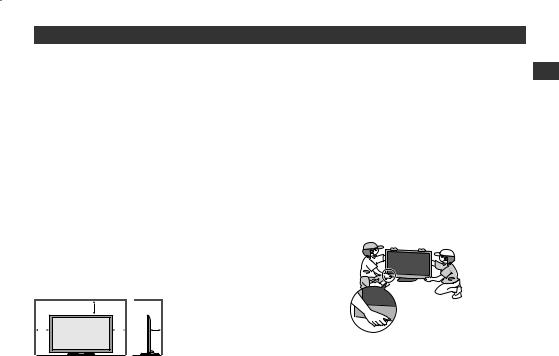
Caution
This appliance is intended for use in tropical climates
When cleaning the TV, remove the mains plug
●Cleaning an energised TV may cause electrical shock.
When the TV is not going to be used for a long period of time, remove the mains plug
●This TV will still consume some power even in the Off mode, as long as the mains plug is still connected to a live socket outlet.
Transport only in upright position
●Transporting the TV with its display panel facing upward or downward may cause damage to the internal circuitry.
Allow sufficient space around the TV for radiated heat
Minimum distance
|
10 |
|
10 |
10 |
7 |
(cm)
●When using the pedestal, keep the space between the bottom of the TV and the surface where the TV is set.
●In case of using Wall-hanging bracket, follow the manual of it.
Do not block the rear air vents
●Blocked ventilation by newspapers, table cloths, curtains, etc. may cause overheating, fire or electrical shock.
Do not expose your ears to excessive volume from the headphones
●Irreversible damage can be caused.
Do not apply strong force or impact to the display panel
●This may cause damage resulting in injury.
The TV is heavy. Handle the TV by 2 or more people. Support as shown to avoid injury by the TV tipping or falling.
Precautions Safety
5

Built-in wireless LAN / Bluetooth
Warning
Radio waves
Safety |
●Do not use the TV and 3D Eyewear in any medical institutions or locations with medical equipment. Radio waves |
from the TV and 3D Eyewear may interfere with the medical equipment and cause accidents due to the malfunction. |
|
|
●Do not use the TV and 3D Eyewear near any automatic control equipment such as automatic doors or fire alarms. |
Precautions |
Radio waves from the TV and 3D Eyewear may interfere with the automatic control equipment and cause accidents |
due to the malfunction. |
|
|
●Keep the distance at least 22 cm from the built-in wireless LAN part and 3D Eyewear when you have a cardiac |
|
pacemaker. Radio waves from them may interfere with the operation of the pacemaker. |
|
●Do not disassemble or alter the built-in wireless LAN and 3D Eyewear in any way |
Caution
■Built-in wireless LAN
●To use the built-in wireless LAN, an access point needs to be obtained.
●Do not use the built-in wireless LAN to connect to any wireless network (SSID ) for which you do not have usage
rights. Such networks may be listed as a result of searches. However, using them may be regarded as illegal access.SSID is a name for identifying a particular wireless network for transmission.
●Do not subject the built-in wireless LAN to high temperatures, direct sunlight or moisture.
●Data transmitted and received over radio waves may be intercepted and monitored.
●The built-in wireless LAN uses 2.4 GHz and 5 GHz frequency bands. To avoid malfunctions or slow response caused by radio wave interference, keep the TV away from the devices such as other wireless LAN devices, microwaves, mobile phones and the devices that use 2.4 GHz and 5 GHz signals when using the built-in wireless LAN.
●When noises occur due to the static electricity, etc., the TV might stop operating for the protection of the devices. In this case, turn the TV off with Mains power On / Off switch, then turn it on again.
●Additional information for built-in wireless LAN and access point may be on the following website. (English only) http://panasonic.jp/support/global/cs/tv/
■Bluetooth® wireless technology
●The TV and 3D Eyewear use the 2.4 GHz radio frequency ISM band (Bluetooth®). To avoid malfunctions or slow response caused by radio wave interference, keep the TV and 3D Eyewear away from the devices such as other wireless LAN devices, other Bluetooth devices, microwaves, mobile phones and the devices that use 2.4 GHz signal.
6

Accessories / Options
Standard accessories
Remote Control |
Batteries for the |
●N2QAYB000749 |
Remote Control (2) |
|
●R6 (AA) |
|
(p. 8) |
3D Eyewear (2)
(TY-ER3D4MA) ●N5ZZ00000260
 (p. 30)
(p. 30)
Terminal adaptors
●AV2 IN (COMPONENT / VIDEO) adaptor
 (p. 79, 80)
(p. 79, 80)
Mains lead
 (p. 14)
(p. 14)
ST50K series
ST50M series
ST50P series
●AV1 IN / AUDIO OUT adaptor
 (p. 79)
(p. 79)
Pedestal |
Clamper |
(p. 9) |
(p. 16) |
(ST50D series) |
(ST50T series) |
Operating Instructions
Options / Accessories
●The shape of accessories may differ from the actual.
●Accessories may not be placed all together. Take care not to throw them away unintentionally.
●This product contains possibly dangerous parts (such as plastic bags), that can be breathed in or swallowed by young children accidentally. Keep these parts out of reach of young children.
Optional accessories
Please contact your local Panasonic dealer to purchase the recommended optional accessories. For additional details, please read the manual of the optional accessories.
3D Eyewear set
(Rechargeable type)
●TY-ER3D4MW ●If you need 3D Eyewears additionally, please purchase this optional accessory.
●TY-ER3D4SW ●Use Panasonic 3D Eyewear for active 3D supporting Bluetooth wireless technology.
 ●For more information (English only):
●For more information (English only):
 http://panasonic.net/avc/viera/3d/asia.html
http://panasonic.net/avc/viera/3d/asia.html
Communication Camera
●TY-CC20W |
●This camera can be used on VIERA Connect (p. 20, 71). |
|
●Depending on the area, this optional accessory may not be available. |
|
For details, consult your local Panasonic dealer. |
7

Options / Accessories
Wall-hanging bracket
●TY-WK4P1RW (42” / 50” class)
●TY-WK6P1RW (65” class)
●Tilting angle for this TV: 0 (vertical) to 20 degrees (42” class) / 10 degrees (50” / 65” class)
Rear of the TV
a
b
Depth of screw:
(42” / 50” class) minimum 10 mm, maximum 16 mm (65” class) minimum 17 mm, maximum 23 mm
Diametre: M8
Screw for fixing the TV onto the wall-hanging bracket (not supplied with the TV)
(View from the side)
Holes for wall-hanging bracket installation a: 400 mm b: 300 mm (42” / 50” class) a: 684 mm b: 300 mm (65” class)
Warning
●Using other wall-hanging brackets, or installing a wall-hanging bracket by yourself have the risk of personal injury and product damage. In order to maintain the unit’s performance and safety, be absolutely sure to ask your dealer or a licensed contractor to secure the wall-hanging brackets. Any damage caused by installing without a qualified installer will void your warranty.
●Carefully read the instructions accompanying optional accessories, and be absolutely sure to take steps to prevent the TV from falling off.
●Handle the TV carefully during installation since subjecting it to impact or other forces may cause product damage.
●Take care when fixing wall brackets to the wall. Always ensure that there are no electrical cables or pipes in the wall before hanging bracket.
●To prevent fall and injury, remove the TV from its fixed wall position when it is no longer in use.
Installing / removing remote’s batteries
1 |
Caution |
Pull open |
●Incorrect installation may cause battery leakage and corrosion, |
|
resulting in damage to the remote control. |
|
●Do not mix old and new batteries. |
Hook |
●Do not mix different battery types (such as alkaline and manganese |
2 |
batteries). |
●Do not use rechargeable (Ni-Cd) batteries. |
|
Close |
●Do not burn or break up batteries. |
|
Batteries must not be exposed to excessive heat such as sunshine, |
|
fire or the like. |
Note the correct |
●Do not disassemble or modify the remote control. |
polarity (+ or -) |
|
8

Attaching / removing the pedestal
Warning
Do not disassemble or modify the pedestal.
●Otherwise the TV may fall over and become damaged, and personal injury may result.
Caution
Do not use any pedestal other than the one provided with this TV.
●Otherwise the TV may fall over and become damaged, and personal injury may result.
Do not use the pedestal if it becomes warped or physically damaged.
●If you use the pedestal while it is physically damaged, personal injury may result. Contact your local Panasonic dealer immediately.
During set-up, make sure that all screws are securely tightened.
●If insufficient care is taken to ensure screws are properly tightened during assembly, the pedestal will not be strong enough to support the TV, and it might fall over and become damaged, and personal injury may result.
Ensure that the TV does not fall over.
●If the TV is knocked or children climb onto the pedestal with the TV installed, the TV may fall over and personal injury may result.
Two or more people are required to install and remove the TV.
●If two or more people are not present, the TV may be dropped, and personal injury may result.
When removing the pedestal from the TV, do not remove the pedestal by the methods other than the specified procedure (p. 11)
●Otherwise the TV and / or pedestal may fall over and become damaged, and personal injury may result.
Assembly screw |
Bracket |
Cover |
Base |
(5) (42” / 50” class) |
●TXFBL5Z0048 |
●TXFBL5Z0049 |
●TBL5ZX0310 |
(1) (65” class) |
(42” / 50” class) |
(42” / 50” class) |
(42” class) |
(black) |
●TXFBL5Z0054 |
|
●TBL5ZX0311 |
|
(65” class) |
|
(50” class) |
|
|
●TXFBL5Z0056 |
●TBL5ZX0380 |
|
|
(65” class) |
|
M4 × 10 |
|
(65” class) |
|
|
|
||
|
|
|
Assembly screw |
Neck |
(7) (42” / 50” class) |
●TXFBL5Z0094 |
(12) (65” class) |
(42” class) |
(silver) |
●TXFBL5Z0063 |
|
(50” class) |
|
●TXFBL5Z0064 |
M5 × 16 |
(65” class) |
Options / Accessories
9

■Assembling the pedestal
1Insert the tabs of the neck  into the base
into the base  firmly
firmly
Tabs (bottom)
|
D |
|
F |
/ Accessories |
|
Options |
3 Attach the bracket to the tabs of the neck |
|
and fix with assembly screws |
|
B |
|
Tabs (top) |
|
C |
D
■Securing the TV
Use the assembly screws  (42” / 50” class) or
(42” / 50” class) or  (65” class) to fasten securely.
(65” class) to fasten securely.
●Tighten the four assembly screws loosely at first, then tighten them firmly to fix securely.
●Carry out the work on a horizontal and level surface.
2Turn the base  over and fix the neck
over and fix the neck  securely with assembly screws
securely with assembly screws 
●Do not hold the neck when turning over the base.
B (3) (42” / 50” class) 42” / 50” class
(4) (65” class)
F
Screw hole
Back of the base
65” class
4Attach the cover  and fix securely with assembly screw
and fix securely with assembly screw 
A
E
Arrow mark
A |
(42” / 50” class) |
B |
(65” class) |
Hole for pedestal installation
10

Removing the pedestal from the TV
Be sure to remove the pedestal in the following way when using the wall-hanging bracket or repacking the TV.
1 Remove the assembly screws  (42” / 50” class) or
(42” / 50” class) or  (65” class) from the TV. 2 Pull out the pedestal from the TV.
(65” class) from the TV. 2 Pull out the pedestal from the TV.
3 Remove the assembly screw  from the cover. 4 Pull out the cover.
from the cover. 4 Pull out the cover.
5 Remove the assembly screws  from the bracket.
from the bracket.
6 Remove the assembly screws  from the Back of stand and pull out the neck.
from the Back of stand and pull out the neck.
Adjusting the panel to your desired angle
●Do not place any objects within the full rotation range.
(42” class) |
(50” class) |
15° |
10° |
(View from the top)
Preventing the TV from falling over (42” / 50” class)
Using the fall-prevent screw hole and a screw (commercially available), securely fix the body of the pedestal to the installation surface.
●The place where the pedestal is to be fixed should be thick enough and made of hard material.
 Screw (not supplied)
Screw (not supplied)
Diametre: 3 mm
Length: 25-30 mm
Screw hole
Options / Accessories
11
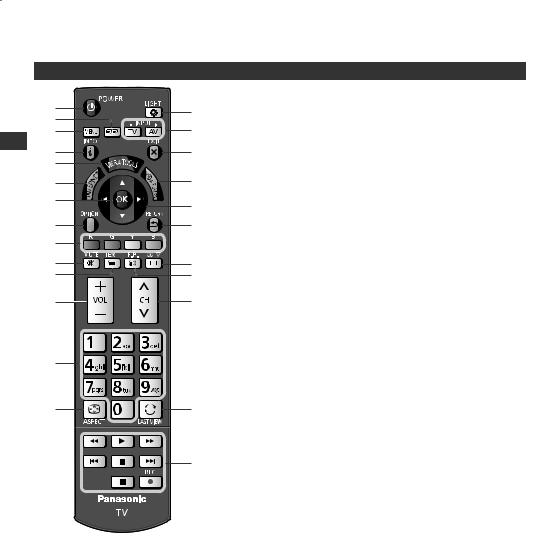
Identifying Controls
Remote Control
|
1 |
15 |
|
|
2 |
||
|
16 |
||
|
3 |
||
Identifying |
4 |
17 |
|
7 |
19 |
||
|
5 |
|
|
|
6 |
18 |
|
Controls |
|
||
8 |
20 |
||
|
|||
|
9 |
|
|
|
10 |
21 |
|
|
11 |
22 |
|
|
12 |
23 |
13
14 |
24 |
25
1Standby On / Off switch
●Switches TV on or off standby.
2 3D button  (p. 34)
(p. 34)
●Switches the viewing mode between 2D and 3D.
3 [Main Menu]  (p. 38)
(p. 38)
●Press to access Picture, Sound, Network, Timer and Setup Menus.
4 Information  (p. 21)
(p. 21)
●Displays channel and programme information.
5 VIERA TOOLS  (p. 37)
(p. 37)
●Displays some special feature icons and accesses easily.
6INTERNET ([VIERA Connect])  (p. 20, 71)
(p. 20, 71)
●Displays VIERA Connect home screen.
7OK
●Confirms selections and choices.
●Press after selecting channel positions to quickly change channel.
●Displays the Channel List.
8[Option Menu]  (p. 22)
(p. 22)
●Easy optional setting for viewing, sound, etc.
9Coloured buttons
●Used for the selection, navigation and operation of various functions.
10Sound Mute
●Switches sound mute on or off.
11Teletext  (p. 25)
(p. 25)
●Switches to teletext mode.
12Volume Up / Down
13Numeric buttons
●Changes channel and teletext pages.
●Sets characters.
●When in Standby mode, switches TV on.
14Aspect  (p. 23)
(p. 23)
●Changes aspect ratio.
15Light
●Lights the buttons for about 5 seconds (except the buttons “25”).
16Input mode selection
●TV - switches TV mode.  (p. 21)
(p. 21)
●AV - switches to AV input mode from Input Selection list.  (p. 27)
(p. 27)
17Exit
●Returns to the normal viewing screen.
18[Media Player]  (p. 53)
(p. 53)
●Switches to SD Card and USB device viewing / listening mode.
19Cursor buttons
●Makes selections and adjustments.
20Return
●Returns to the previous menu / page.
21Sound Selection
●Changes multiplex sound mode (if available).
 (p. 83)
(p. 83)
22Favourite Page  (p. 25)
(p. 25)
●Calls up the teletext page stored in blue button.
23Channel Up / Down
24Last view  (p. 24)
(p. 24)
●Switches to previously viewed channel or input mode.
25Operations for contents, connected equipment, etc.  (p. 28, 53, 68, 77)
(p. 28, 53, 68, 77)
Some countries do not provide a teletext service.
12

Indicator / Control panel
|
|
|
1 |
|
|
|
2 |
|
|
|
3 |
5 |
6 |
7 |
4 |
|
Rear side of the TV
1Function select
●[Volume] / [Contrast] / [Brightness] / [Colour] / [Sharpness] / [Tint] (NTSC signal) / [Bass] / [Treble] / [Balance] / [Auto Tuning]
[Music] or [Speech] mode in the Sound Menu
2Channel Up / Down, Value change (when using the F button), Switching the TV on
3Changes the input mode
4Mains power On / Off switch
●Use to switch the mains power.
If you turned the TV off during Standby mode by the remote control last time, the TV will be in Standby mode when you turn the TV on with Mains power On / Off switch.
●When pressing the control panel button (1 - 4), the control panel guide appears on the right side of the screen for 3 seconds to highlight the pressed button.
5Remote control signal receiver
●Do not place any objects between the TV remote control signal receiver and remote control.
6C.A.T.S. (Contrast Automatic Tracking System) sensor
●Senses brightness to adjust picture quality when [Eco Mode] in the Picture Menu is set to [On].
 (p. 39)
(p. 39)
7Power LED
Red: Standby
Green: On
●The LED blinks when the TV receives a command from the remote control.
Controls Identifying
Using the On Screen Displays - Operation guide
Many features available on this TV can be accessed via the On Screen Display menu.
■Operation guide
Operation guide will help you to operate by using the remote control.
Example: [Sound Menu]
|
Main Menu |
|
|
|
|
|
1/2 |
|
||||
|
|
|
|
|
|
|
|
|
|
|
|
|
|
|
Picture |
Mode |
Music |
|
|
|
|
||||
|
|
Bass |
|
|
|
|
0 |
|
|
|||
|
|
Sound |
Treble |
|
|
|
|
0 |
|
|
||
|
|
Balance |
|
|
|
|
0 |
|
|
|||
|
|
Network |
Headphone Volume |
|
|
|
|
11 |
|
|
||
|
|
Surround |
Off |
|
|
|
|
|||||
|
|
Timer |
Volume Control (VAO) |
TV |
|
|
|
|
||||
|
|
Auto Gain Control |
Off |
|
|
|
|
|||||
|
|
Setup |
Volume Correction |
|
|
|
|
0 |
|
|
||
|
|
|
|
|
|
|
|
|
|
|||
|
|
|
|
|
|
|
|
|
|
|
|
|
|
Select |
|
|
|
|
|
|
|
|
|
||
|
|
Selects your favourite sound |
|
Page up |
|
|
||||||
Change |
EXIT |
|
|
|
|
|||||||
|
|
|
|
|
mode. |
|
|
|
Page down |
|
|
|
|
|
|
RETURN |
|
|
|
|
|
|
|
|
|
■How to use remote control
Open the main menu
Move the cursor / select from a range of options / select the menu item (up and down only) / adjust levels (left and right only)
Access the menu / store settings after adjustments have been made or options have been set
Return to the previous menu
Exit the menu system and return to the normal viewing screen
Operation guide
Auto power standby function
The TV will automatically go into Standby mode in the following conditions:
•No signal is received and no operation is performed for 30 minutes in TV mode.
•[Off Timer] is active in the Timer Menu. (p. 22)
•No operation is performed for the period selected in [Auto Standby] (p. 43).
13
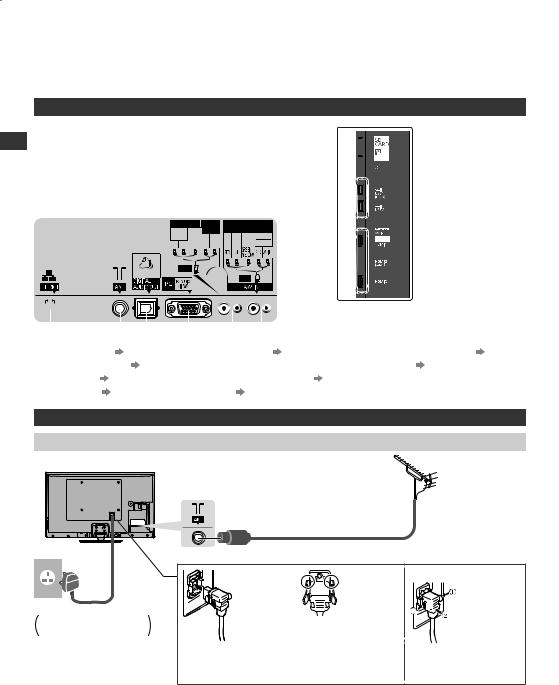
Basic Connection
External equipment and cables shown are not supplied with this TV.
Please ensure that the unit is disconnected from the mains socket before attaching or disconnecting any leads. When disconnecting the mains lead, be absolutely sure to disconnect the mains plug at the socket outlet first.
Terminals


















 Connection Basic
Connection Basic
1


2
3 


4 

|
|
|
|
|
|
|
|
|
|
|
|
|
|
|
|
|
|
|
|
|
|
|
|
|
|
|
|
|
|
|
|
|
|
|
|
|
|
|
|
|
|
|
|
|
|
|
|
|
|
|
|
|
|
|
|
|
|
|
|
|
|
|
|
|
|
|
|
|
|
|
|
|
|
|
|
|
|
|
|
||||
5 |
|
|
6 |
7 |
8 |
|
9 |
10 |
|
|
||||||||||
1 |
SD Card slot |
|
(p. 52) |
|
|
5 |
ETHERNET (p. 16, 63) |
9 |
AV1 IN / AUDIO OUT (p. 79) |
|||||||||||
2 |
Headphone jack |
(p. 80) |
|
|
6 |
Antenna terminal (see below) |
10 |
AV2 IN (p. 79, 80) |
||||||||||||
3 |
USB 1 - 2 (p. 52, 80) |
|
|
7 |
DIGITAL AUDIO OUT (p. 79) |
|
|
|||||||||||||
4 |
HDMI1 - 3 |
(p. 15, 79) |
|
|
8 |
PC |
(p. 80) |
|
|
|||||||||||
Connections
Mains lead and aerial
Mains lead
AC 220-240 V, 50 / 60 Hz ST50P series:
AC 110-240 V, 50 / 60 Hz
 Aerial
Aerial
■TV |
|
■Mains lead |
RF cable |
|
Make sure that the mains lead is
Push until both side securely fixed tabs click
To remove from the TV:

 tabs
tabs
Press both tabs and pull on mains connector to release
14
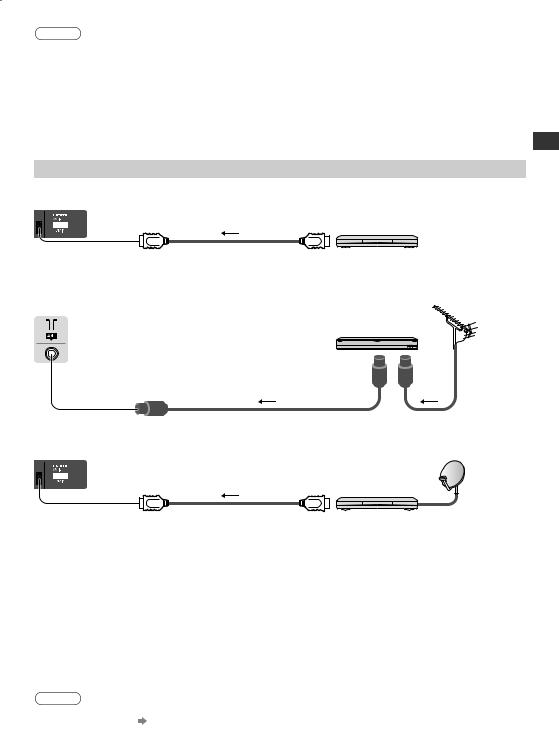
Note
●Keep RF (antenna) cable away from the mains lead to avoid and minimise mains interference pickup.
●Do not place the RF cable under the TV.
●To obtain optimum quality picture and sound, an aerial, the correct cable (75 Ω coaxial), and the correct terminating plug are required.
●If a communal aerial system is used, you may require the correct connection cable and plug between the wall aerial socket and the TV.
●Your local Television Service Centre or dealer may be able to assist you in obtaining the correct aerial system for your particular area and the accessories required.
●Any matters regarding aerial installation, upgrading of existing systems or accessories required, and the costs incurred, are the responsibility of you, the Customer.
AV devices
■Player / 3D compatible player
TV
|
Player / |
|
3D-compatible player |
|
HDMI cable |
■DVD Recorder / VCR |
Aerial |
TV |
|
|
DVD Recorder / VCR |
RF cable |
RF cable |
■Set top box
TV
Satellite dish
Set top box
HDMI cable
Note
●Check the type of terminals and cable plugs are correct when connecting. ●VIERA Link connection (p. 72, 73)
●Please also read the manual of the equipment being connected.
●Keep the TV away from electronic equipment (video equipment, etc.) or equipment with an infrared sensor.
Connection Basic
Otherwise, distortion of image / sound may occur or operation of other equipment may be interfered. |
|
●When using a HDMI cable, use the fully wired one. |
15 |
|

Network
To enable the network service functions (VIERA Connect, etc.), you need to connect the TV to a broadband network environment.
●If you do not have any broadband network services, please consult your retailer for assistance.
●Prepare the internet environment for wired connection or wireless connection.
●Setup of the network connection will start after the tuning (when first using the TV).  (p. 17 - 19)
(p. 17 - 19)
■Wired connection
TV
Connection Basic
LAN cable (Shielded)
●Use the Shielded Twist Pair (STP) LAN cable.
■Wireless connection
Access point
Internet environment
Built-in wireless LAN
Internet environment
Using clamper
●Do not bundle the RF cable and mains lead together (could cause distorted image).
●Fix cables with clampers as necessary.
●When using the optional accessory, follow the option’s assembly manual to fix cables.
■Clamper (Standard accessory)
Attach the clamper |
Bundle the cables |
||
hole |
|
|
|
Insert the |
|
|
|
clamper in a hole |
|
Set the tip in |
|
|
|
the hooks |
|
|
hooks |
|
|
To remove from the TV: |
To loosen: |
|
|
snaps |
|
|
|
Keep pushing |
|
Keep pushing |
|
both side snaps |
knob |
||
the knob |
|||
|
|||
16

Auto Tuning
Search and store TV channels automatically.
●These steps are not necessary if the setup has been completed by your local dealer.
●Please complete connections (p. 14 - 16) and settings (if necessary) of the connected equipment before starting Auto Tuning. For details of settings for the connected equipment, read the manual of the equipment.
1Plug the TV into mains socket and switch on
●Takes a few seconds to be displayed.
●If the red LED shows on the TV, press the Standby On / Off switch on the
remote control.
2 Select your language
OSD Language
English
3 SelectCountry your country
Thailand |
|
Vietnam |
India |
|
Malaysia |
Singapore |
|
Indonesia |
United Arab Emirates |
|
Saudi Arabia |
Kuwait |
|
Others |
4 Select your area
Channel Plan
Asia/W.Europe
CIS/E.Europe
China
Hong Kong
NZ/Indonesia
CATV/Other

 select
select 
 set
set

 select
select 
 set
set

 select
select 
 access
access
●When selecting [CATV/Other], press the OK button, and then select the Channel Plan from Indian CATV, South Africa, American System, American CATV or Japan CATV.
Auto Tuning starts
●Auto Tuning will start to search for TV channels and store them.
The stored channels and sorted channel order vary depending on the area, broadcasting system and conditions of signal reception.
Auto Tuning
2 |
|
CH 4 |
Scan |
1 |
120 |
5 Setup the network connection
Setup the network connection to enable the network service functions such as VIERA Connect, etc. (p. 20, 62).
●Please note that this TV does not support wireless public access points.
●Ensure the network connections (p. 16) and network environment are completed before starting setup.
Select the network type
Network Setup |
|
[Wired] |
“Wired connection” (p. 16) |
|
|
[Wireless] |
“Wireless connection” |
Select Wired or Wireless |
(p. 16) |
||
Wired Wireless |
Set later |
||



 select
select
 access
access
●To setup later on or skip this step
 Select [Set later] or
Select [Set later] or 
Tuning Auto
17
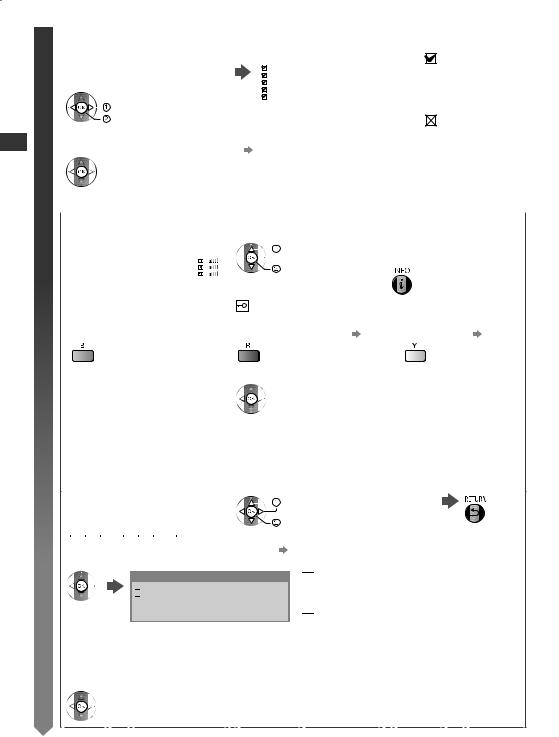
Tuning Auto
5 |
■[Wired] |
|
|
|
|
|
|
|
|
|
|
|
|
|
|
||||
|
1. Select [Auto] |
|
|
|
|
|
|
|
|
|
|
|
|
|
|
||||
|
|
|
|
|
|
|
|
|
|
Connection Test |
|
|
: succeeded |
||||||
|
|
Acquire IP Address |
|
|
|
|
|
|
|
|
Check network cable connection. |
|
The test is successful |
||||||
|
|
|
|
|
|
|
|
|
|
Check acquired IP address. |
|
|
|||||||
|
|
|
|
Auto |
|
|
Manual |
|
|
|
|
Check for devices using same IP address. |
|
and the TV is |
|
||||
|
|
|
|
|
|
|
|
|
|
|
|
|
|
Check gateway connection. |
|
|
connected to the |
||
|
|
|
|
|
|
|
|
|
|
|
|
|
|
Check server connection. |
|
|
|||
|
|
|
|
|
select |
|
|
|
Automatically setup is done and the test of the |
|
network. |
|
|||||||
|
|
|
|
|
|
|
|
|
|
||||||||||
|
|
|
|
|
access |
|
|
|
|
: failed |
|
||||||||
|
|
|
|
|
|
|
|
|
network connection starts. |
|
|
|
|||||||
|
|
|
|
|
|
|
|
|
|
|
Check the settings and |
||||||||
|
|
|
|
|
|
|
|
|
●To set manually, select [Manual] and set each item. |
||||||||||
|
|
2. Go to the next step |
|
|
connections. And then |
||||||||||||||
|
|
|
|
For details (p. 65) |
|
|
|||||||||||||
|
|
|
|
(Press twice) |
|
|
|
|
|
|
|
|
|
select [Retry]. |
|
||||
|
|
|
|
|
|
|
|
|
|
|
|
|
|
|
|||||
|
|
|
|
|
|
|
|
|
|
|
|
|
|
|
|
|
|
|
|
|
■[Wireless] |
|
|
|
|
|
|
|
|
|
|
|
|
|
|
||||
|
|
Access points found automatically are listed. |
|
|
|
|
|||||||||||||
|
|
1. Select your desired access point |
|
|
|
|
|
|
●For the information of the |
||||||||||
|
|
|
|
|
|
|
|
|
|
|
select |
||||||||
|
|
Available Wireless Networks |
|
|
|
|
|
||||||||||||
|
|
1 |
Access Point A |
11n(2.4GHz) |
Status |
|
|
|
|
|
|
|
highlighted access point |
||||||
|
|
No. |
Network Name(SSID) |
Wireless type |
|
|
|
|
|
|
|
|
|
|
|||||
|
|
|
|
|
|
|
|
|
|
|
|
|
|
|
access |
|
|
|
|
|
|
2 |
Access Point B |
11n(5GHz) |
|
|
|
|
|
|
|
|
|
|
|
||||
|
|
3 |
Access Point C |
11n(5GHz) |
|
|
|
: Encrypted access point |
|
|
|
|
|||||||
|
|
|
|
|
|
|
|
|
|
|
|
|
|
|
|
||||
|
|
|
|
|
|
|
|
|
|
|
|
|
|
|
|
||||
|
|
|
|
|
|
|
|
|
|
|
|
|
|
|
|
||||
|
|
|
|
|
|
|
|
|
|
|
|
|
|
|
|
||||
|
|
|
|
|
|
|
|
|
|
|
|
|
|
|
|
||||
|
|
●To search access points again |
●To set [WPS(Push button)] |
(p. 19) |
●To set manually |
(p. 67) |
|||||||||||||
|
|
2. Access the encryption key input mode |
|
|
|
|
|||||||||||||
|
|
|
|
|
|
|
|
|
|
|
|
|
|
|
|
|
|||
|
|
Encryption Key Setting |
|
|
|
|
|
|
|
|
|
|
|
|
|
|
|||
|
|
Connection will be made with the following settings:- |
|
|
|
|
|
|
|
|
|
|
|||||||
|
|
Network Name(SSID): Access Point A |
|
|
|
|
|
|
|
|
|
|
|
||||||
|
|
Security type: WPA-PSK |
|
|
|
|
●If the selected access point is not encrypted, the confirmation |
||||||||||||
|
|
Encryption type: TKIP |
|
|
|
|
|||||||||||||
|
|
Please input the encryption key. |
|
|
screen will be displayed. It is recommended to select the encrypted |
||||||||||||||
|
|
|
|
|
|
|
|
|
|
|
access point. |
|
|
|
|
||||
|
|
Encryption key |
|
|
|
|
|
|
|
|
|
|
|
|
|
|
|||
3. Enter the encryption key of the access point (English only)
|
|
|
|
|
|
|
|
|
|
|
|
|
|
|
|
|
|
|
|
|
Set characters |
Store |
|||
|
Wireless Network Settings |
|
|
|
|
|
|
|
|||||||||||||||||
|
Encryption key |
|
|
|
|
|
|
|
|
|
|
|
|
|
|
|
|
select |
|
||||||
|
A |
B |
C |
D |
E |
F |
G |
H |
I |
J |
K |
L |
M |
N |
O |
P |
Q |
R |
S |
T |
|
|
|
|
|
|
U |
V |
W |
X |
Y |
Z |
|
0 |
1 |
2 |
3 |
4 |
5 |
6 |
7 |
8 |
9 |
! |
: |
# |
|
|
|
set |
|
|
a |
b |
c |
d |
e |
f |
g |
h |
i |
j |
k |
l |
m |
n |
o |
p |
q |
r |
s |
t |
|
|
|
|
|
|
u |
v |
w |
x |
y |
z |
( |
) |
+ |
- |
. |
* |
_ |
@ |
/ |
“ |
‘ |
% |
& |
? |
●You can set characters by using numeric |
|
|||
|
, |
; |
= |
$ |
[ |
] |
~ |
< |
> |
{ |
} |
| |
` |
^ |
\ |
|
|
|
|
|
|
||||
|
|
|
|
|
|
|
|
|
|
|
|
|
|
|
|
|
|
|
|
|
buttons. |
(p. 89) |
|
||
4. After the access point setting is finished, perform the connection test
Connection Test
 Check wireless network connection.
Check wireless network connection.
 Check acquired IP address.
Check acquired IP address.
 Check for devices using same IP address.
Check for devices using same IP address.
 Check gateway connection.
Check gateway connection.  Check server connection.
Check server connection.
 : succeeded
: succeeded
The test is successful and the TV is connected to the network.
 : failed
: failed
Check the settings and connections. And then select [Retry].
To set manually, select [Manual] and set each item. For details  (p. 67)
(p. 67)
5. Go to the next step 
(Press twice)
18

5 |
|
[WPS(Push button)] |
|
|
|
|
|
|||||
|
1. Press the WPS button on the access point until the light flashes |
|||||||||||
|
|
2. Connect the TV with the access point |
|
|
|
|
|
|||||
|
|
|
|
|
|
|
|
|
|
|
|
|
|
|
WPS(Push button) |
|
|
|
|
|
|
|
|
|
|
|
|
1) Please press the ‘WPS’ button on the wireless |
|
|
|
|
|
|
||||
|
|
access point until its light flashes. |
|
|
|
|
|
|
||||
|
|
2) When the light is flashing select ‘Connect’ on |
|
●Ensure that your access point supports WPS for this setup. |
||||||||
|
|
TV. |
|
|
|
|
|
|||||
|
|
If you are unsure, please check the instruction |
|
●WPS: Wi-Fi Protected Setup™ |
||||||||
|
|
|
●If the connection has failed, check the settings and positions of |
|||||||||
|
|
manual of the wireless access point. |
|
|||||||||
|
|
|
Connect |
|
your access point. And then, follow the on-screen instructions. |
|||||||
|
|
3. After the access point setting is finished, perform the connection test |
||||||||||
|
|
|
|
|
|
|
|
|
|
|
: succeeded |
|
|
|
|
|
Connection Test |
|
|
|
|
||||
|
|
|
|
Check wireless network connection. |
|
The test is successful and the TV is connected to |
||||||
|
|
|
|
Check acquired IP address. |
|
|
|
|
||||
|
|
|
|
Check for devices using same IP address. |
|
the network. |
||||||
|
|
|
|
Check gateway connection. |
|
|
|
|
: failed |
|||
|
|
|
|
Check server connection. |
|
|
|
|
||||
|
|
4. Go to the next step |
|
|
|
|
|
|
Check the settings and connections. And then select |
|||
|
|
|
|
|
|
|
||||||
|
|
(Press twice) |
|
|
|
|
[Retry]. |
|||||
|
|
|
|
|
|
|
||||||
|
|
|
|
|
|
|
|
|
|
|
|
|
6 |
Select [Home] |
|
|
|
|
|
||||||
Select [Home] viewing environment to use in your home environment. |
||||||||||||
|
Please select your viewing environment. |
|
|
|
select |
|||||||
|
|
Home |
|
|
Shop |
|
|
|
||||
|
|
|
|
|
|
|
||||||
 set
set
■[Shop] viewing environment (for shop display only)
[Shop] viewing environment is the demonstration mode to explain main features of this TV.
Select [Home] viewing environment to use in your home environment.
●You can return to viewing environment selection screen at the stage of Shop confirmation screen.
1Return to viewing environment |
2Select [Home] |
|
|
|
selection screen |
Please select your viewing environment. |
|
select |
|
Shop |
Home |
Shop |
|
|
|
||||
 set
set
You have selected shop mode
To change viewing environment later on, you will need to initialise all settings by accessing Shipping Condition.  [Shipping Condition] (p. 49)
[Shipping Condition] (p. 49)
Auto Tuning is now complete and your TV is ready for viewing
If tuning has failed, check the connection of the RF cable, and then, follow the on-screen instructions.
Note
●To edit or hide (skip) channels “Tuning and Editing Channels” (p. 45 - 47)
●To retune all channels |
Tuning] in “Tuning and Editing Channels” (p. 46, 47) |
●To initialise all settings |
[Shipping Condition] (p. 49) |
Tuning Auto
19

Using “VIERA Connect”
VIERA Connect is a gateway to the internet services unique to Panasonic.
VIERA Connect allows you to access some specific websites supported by Panasonic, and enjoy internet contents such as videos, games, communication tools, etc. from VIERA Connect home screen.
●Some features of the websites may not be available.
1


 2
2
Using |
■To exit from |
|
VIERA Connect |
||
|
||
“VIERA |
●To set the VIERA |
|
Connect introduction |
||
Connect” |
banner display off |
|
[VIERA Connect |
||
|
Banner] (p. 43) |
Turn power on
●Mains power On / Off switch should be on. (p. 13)
●Every time you turn on the TV, VIERA Connect introduction banner appears. The banner is subject to change.
Enjoy selected internet content with VIERA Connect.
Simply press the OK / INTERNET button
Access VIERA Connect
While the banner is displayed
or
●Depending on the usage conditions, it may take a while to read all the data.
●Messages might be displayed before VIERA Connect home screen.
Please read these instructions carefully and follow the on-screen instructions.
Example: VIERA Connect home screen
●To go to the next level, select [MORE].
●To back to the previous level, select [BACK].
●To return to VIERA Connect home screen
MORE
BACK
●Video communication requires an exclusive Communication Camera TY-CC20W.
 “Optional accessories” (p. 7)
“Optional accessories” (p. 7)
For details, read the manual of the Communication Camera.
●You can connect a keyboard and a gamepad via USB port for character input and playing games in VIERA Connect. You can also operate the TV with a keyboard or a gamepad other than VIERA Connect features.
For more information  “USB connection” (p. 89)
“USB connection” (p. 89)
Note
●If you cannot access VIERA Connect, check the network connections (p. 16) and settings (p. 17 - 19). ●For more information of VIERA Connect (p. 71)
20
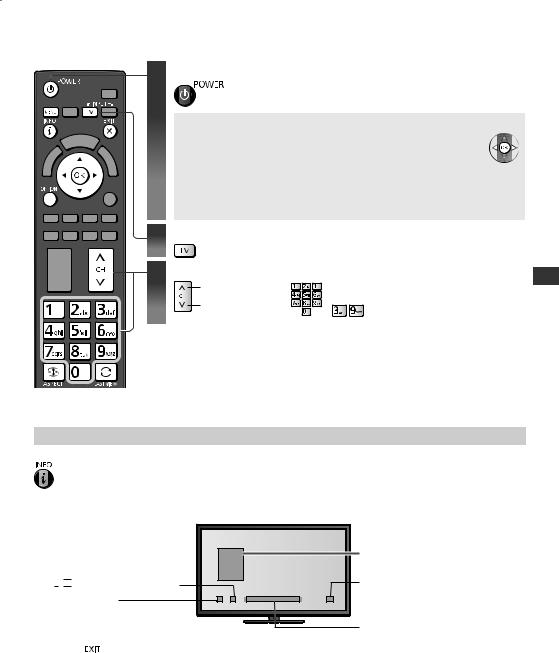
Watching TV
1
2
3
Other useful functions
Turn power on
●Mains power On / Off switch should be on. (p. 13)
■VIERA Connect introduction banner appears
Every time you turn on the TV, this banner appears at the bottom of the screen.
You can access to VIERA Connect easily and enjoy the various contents.  (p. 20)
(p. 20)
●To remove this banner, leave for about 5 seconds or press any buttons (except the buttons to access VIERA Connect).
●To set this banner display off  [VIERA Connect Banner] (p. 43)
[VIERA Connect Banner] (p. 43)
●The banner is subject to change.
Select TV mode
Select a channel
up |
|
●To select the two-digit channel position |
down |
or |
number, e.g. 39 |
|
|
Display Information banner
Display Information banner
●Also appears when changing a channel.
 ,
,  , II ,
, II ,  Audio mode (p. 83)
Audio mode (p. 83)
 Sound mute On
Sound mute On
●To hide 

TV |
|
|
|
|
|
Input mode |
|
|
|
|
|
|
|||
1 |
|
|
|
|
|
|
Channel position |
|
|
|
|
|
|
||
CH08 |
|
|
|
Channel number |
|||
|
|
|
|||||
5.5MHz |
|
|
Sound system |
||||
|
|
||||||
PAL |
|
|
Colour system |
||||
|
|
||||||
16:9 |
|
|
|
|
Aspect ratio |
||
|
|
|
|
||||
1 - 90 Off Timer remaining time ●For settings  (p. 22)
(p. 22)
Teletext
(varies depending on the broadcasters)
Teletext service available
TV Watching
21

Display the selectable settings for the current status
Confirm or change the current status instantly
●To change |
|
select |
select / change |
access |
store |
[Channel Colour Set] |
[MPX] |
Sets colour density |
Selects multiplex sound mode (if available) |
(p. 39) |
(p. 42) |
[Teletext Character Set] |
[Volume Correction] |
Sets the teletext language |
Adjusts volume of individual channel or input mode |
(p. 43) |
|
TV Watching
Off Timer
Turn the TV to Standby mode automatically after a fixed period 1Display the menu
2Select [Timer]

 select
select
Timer
 access
access
3Select [Off Timer] and set the time in 15-minute increments
|
Off |
|
Off Timer |
15 minutes |
|
Auto Standby |
||
30 minutes |
||
|
||
|
45 minutes |
|
|
60 minutes |
|
|
75 minutes |
|
|
90 minutes |
select [Off Timer] |
select the time |
access |
store |
●To cancel, set to [Off] or turn the TV off.
●To confirm the remaining time  “Display Information banner” (p. 21)
“Display Information banner” (p. 21)
●When the remaining time is within 3 minutes, the remaining time will flash on the screen.
22
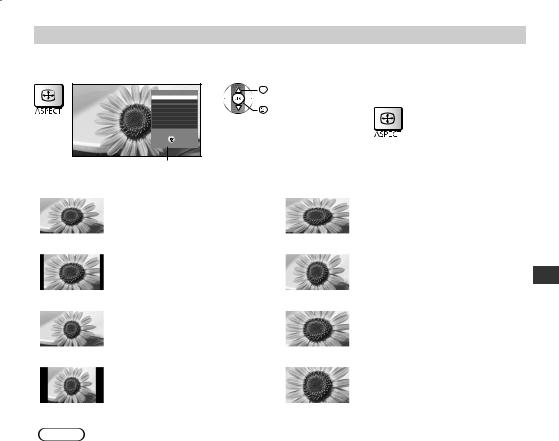
Aspect
Change the aspect ratio (image size)
1Display Aspect Selection list
Aspect Selection
16:9
14:9 Just 4:3 4:3 Full Zoom1 Zoom2 Zoom3
Select Change
 EXIT
EXIT
 RETURN
RETURN
Aspect Selection list
[16:9]
2While the list is displayed, select the mode
select |
●You can also change the mode only |
store |
using the ASPECT button. |
|
[4:3 Full]
|
Directly displays the image at 16:9 |
|
Displays a 4:3 image enlarged |
|
|
||
|
without distortion (anamorphic). |
|
horizontally to fit the screen. |
|
|
|
●For HD signal |
|
|
|
|
[14:9] |
|
[Zoom1] |
|
|
Displays the image at the standard |
|
Displays a 16:9 letterbox or 4:3 image |
|
|
||
|
14:9 without distortion. |
|
without distortion. |
|
|
|
|
[Just] |
[Zoom2] |
||
|
Displays a 4:3 image full-screen. |
|
Displays a 16:9 letterbox (anamorphic) |
|
|
||
|
Stretching is only noticeable at the left |
|
image full-screen without distortion. |
|
and right edges. |
|
|
|
|
|
|
[4:3] |
|
[Zoom3] |
|
|
Displays the image at the standard 4:3 |
|
Displays a 2.35:1 letterbox |
|
|
||
|
without distortion. |
|
(anamorphic) image full-screen without |
|
|
|
distortion. |
|
|
|
At 16:9, displays the image at its |
|
|
|
|
|
|
|
maximum (with slight enlargement). |
Note
●Only [16:9] and [4:3] are available in PC input mode.
●Aspect cannot be changed in teletext service and 3D mode.
●Aspect mode can be memorised separately for SD (Standard definition) and HD (High definition) signals.
TV Watching
23
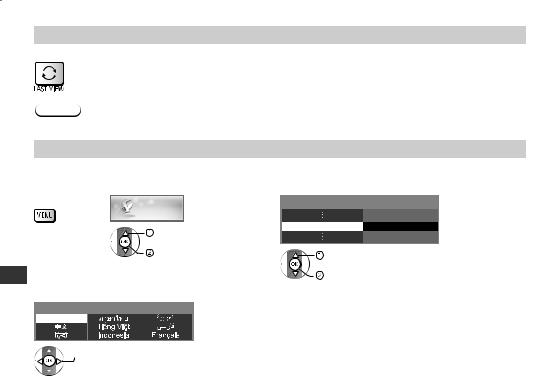
TV Watching
Last view
Switch to previously viewed channel or input mode easily
●Press again to return to the current view.
Note
●Watching less than 10 seconds is not regarded as the previously viewed channel or input mode.
Change OSD language
You can change language for on-screen displays.
1Display the |
2Select [Setup] |
3Select [OSD Language] |
|
menu |
|
|
|
|
Setup |
|
|
|
select |
OSD Language |
Access |
|
|
|
|
|
access |
select |
|
|
|
access |
|
4Select the language and set
OSD Language
English

 select
select 
 set
set
24
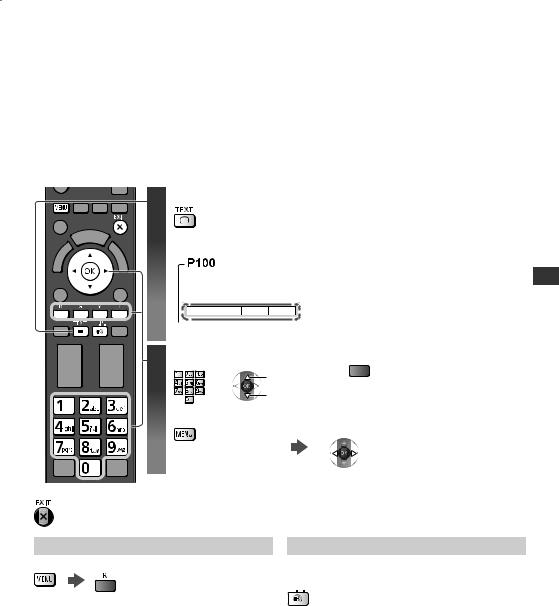
Viewing Teletext
Teletext services are the text information provided by the broadcasters. The features may vary depending on the broadcasters.
What is FASTEXT mode?
In FASTEXT mode, four differently coloured subjects are situated at the bottom of the screen. To access more information about one of these subjects, press the appropriate coloured button. This facility enables fast access to information on the subjects shown.
What is List mode?
In List mode, four differently coloured page numbers are situated at the bottom of the screen. Each of these numbers can be altered and stored in the TV’s memory.  “Store frequently viewed pages” (p. 26)
“Store frequently viewed pages” (p. 26)
■To change mode  [Teletext] (p. 43)
[Teletext] (p. 43)
1 Switch to Teletext |
|
|
●Displays the index page (content varies |
||||||||
|
|
|
|
|
|
|
|
|
|
|
depending on the broadcasters). |
|
|
|
|
|
|
|
|
|
|||
|
|
|
|
|
|
|
|
|
|||
|
|
Sub page number |
|
||||||||
|
|
|
|
|
|
||||||
|
|
|
|
|
|
|
|
|
|
||
|
|
|
|
|
|
|
|
|
|
|
|
|
|
<< 01 02 03 04 05 06 07 |
|
>> |
|
|
|
||||
|
|
|
|
|
|
17:51 28 Feb |
|
Time / date |
|||
|
|
|
|
|
|
|
|||||
|
|
|
TELETEXT |
|
|
|
|
||||
|
|
|
INFORMATION |
|
|
|
|
||||
|
|
|
|
|
|
|
|
|
|
|
Colour bar |
|
|
|
|
|
|
|
|
|
|
|
|
|
|
|
|
|
|
|
|
|
|
|
|
Current page number |
|
|
|
|
|||||||
2 Select the page
up |
or Coloured button |
or |
|
down |
(Corresponds to the colour bar) |
■To adjust contrast
As the blue bar is displayed
(Press three times)
■To return to TV
Teletext Viewing
Reveal hidden data
Reveal hidden words e.g. quiz page answers
●Press again to rehide.
Call up a favourite page
View a favourite page stored
Call up the page stored on the blue button (List mode). 
 ●Factory setting is “P103”.
●Factory setting is “P103”.
25

FULL / TOP / BOTTOM
(TOP) |
|
|
|
(BOTTOM) |
|
|
Normal (FULL) |
|||||
|
|
|
|
|
|
|
|
|
|
|
|
|
|
|
|
|
|
|
|
|
|
|
|
|
|
|
|
|
|
|
|
|
|
|
|
|
|
|
|
|
|
|
|
|
|
|
|
|
|
|
|
|
|
|
|
|
|
|
|
|
|
|
|
|
|
|
|
|
|
|
|
|
|
|
|
|
|
|
|
|
|
|
|
|
|
|
|
|
|
|
|
|
|
|
|
|
|
|
|
|
|
|
|
|
|
|
|
|
|
|
|
|
|
|
|
|
(Expand the TOP half) (Expand the BOTTOM half)
View in multi window
Watch TV and Teletext in two windows at once
(Press twice)
●Operations can be made only in teletext screen.
Teletext Viewing
Store frequently viewed pages
Store frequently viewed pages in the colour bar (List mode only)
As page is displayed
(Corresponding |
press and hold |
|
|
coloured button) |
|












 The number changes to white.
The number changes to white.
■To change stored pages
|
Enter new page number |
Coloured button you |
press and hold |
|
|
want to change |
|
View sub page
View sub page (Only when Teletext is more than one page)

 Appears at top of the screen
Appears at top of the screen
●The number of sub pages varies depending on the broadcasters.
●It may take some time for searching, during which time you can watch TV.
■To view specific sub page
Enter the 4-digit number Example: P6
Watch TV while waiting for update
View the TV picture while searching for a teletext page
Teletext automatically updates itself when new information becomes available.
Changes to TV screen temporarily |
|
P108 |
Appears when |
|
updating is completed |
(You cannot change the channel.) |
|
●The news page provides a function that indicates arrival of the latest news (“News Flash”).
View the updated page
26

Watching External Inputs
Connect the external equipment (VCRs, DVD equipment, etc.) and you can watch through the input. ●To connect the equipment  (p. 14 - 16, 79 - 81)
(p. 14 - 16, 79 - 81)
The remote control is capable of operating the contents or external equipment.  (p. 28)
(p. 28)
1 Turn the TV on
If input mode is not switched automatically
Perform  and
and 
●Check the setup of the equipment.
2 Display the input selection menu
3 Select the input mode connected to the equipment |
|
Input Selection |
select |
AV1 |
watch |
AV2 |
|
PC
HDMI1
HDMI2
HDMI3
TV
SD Card/USB
●You can also select the input using the AV button on the remote control or the TV (except [SD Card/USB]).
Press the button repeatedly until the desired input is selected.
●To switch between [COMPONENT] and [VIDEO] in [AV2], move the indicator by pressing left and right cursor button.
●[SD Card/USB]: Switches to Media Player.  “Using Media Player” (p. 52)
“Using Media Player” (p. 52)
●You can label or skip each input mode (except [SD Card/USB]).
 “Input Labels” (p. 43)
“Input Labels” (p. 43)
Skipped inputs will not be displayed when the AV button is pressed.
4 View
AV1
■To return to TV
Inputs External Watching
Displays the selected mode
Note
●If the external equipment has an aspect adjustment function, set it to “16:9”.
●For details, read the manual of the equipment or ask your local dealer.
27

Inputs External Watching
Operating contents or the equipment with the TV remote control
You can operate the contents in Media Player / media servers, recording functions or the connected equipment.
Play
Playback videocassette / DVD / video content
Stop
Stop the operations
Rewind / Search
VCR:
Rewind, view the picture rapidly in reverse
DVD / video content:
Press and hold to search backward
Skip
DVD / video content:
Skip to the previous track, title or chapter
Fast-forward / Search
VCR:
Fast-forward, view the picture rapidly forward
DVD / video content:
Press and hold to search forward
Skip
DVD / video content:
Skip to the next track, title or chapter
Pause
Pause / Resume
Record
Start recording
How to change the code
Each type of the Panasonic equipment has its own remote control code.
Change the code according to the equipment you want to operate.
Press and hold |
during the following operations |
|
||
Enter the appropriate code, |
Press |
|
||
see table below |
|
|
|
|
|
Type of the equipment, features |
|
Code |
|
DVD Recorder, DVD Player, Blu-ray Disc Player |
70 |
|||
Player theatre, Blu-ray Disc theatre |
71 |
|||
|
VCR |
|
72 |
|
Using in Video mode of Media Player |
(p. 53) |
73 |
||
Using in Video mode of DLNA (p. 68) |
||||
(default) |
||||
The equipment using in VIERA Link |
(p. 77) |
|||
|
||||
Note
●Confirm if the remote control works correctly after changing the code.
●The codes may be reset to default values if batteries are replaced.
●Some operations may not be possible on some equipment models.
28

Viewing 3D images
You can enjoy viewing 3D images with contents or programmes corresponding to the 3D effect by wearing the 3D Eyewear (supplied).  “Standard accessories” (p. 7)
“Standard accessories” (p. 7)
This TV supports [Frame Sequential] 1, [Side by Side] 2 and [Top and Bottom] 3 3D formats.
1: The 3D format that the images for the left and right eyes are recorded with the high definition quality and alternately played back.
2, 3: Other available 3D formats
●How to view the 3D images  (p. 34)
(p. 34)
Warning
Small Parts
●3D Eyewear contains small parts (battery, etc.) and must be kept out of reach of small children to avoid accidental ingestion.
Disassembly
●Do not disassemble or modify the 3D Eyewear.
Lithium Battery
●Batteries must not be exposed to excessive heat such as sunshine, fire or the like.
Caution
To use 3D Eyewear safely and comfortably, please read these instructions fully.
3D Eyewear
●Do not drop, exert pressure on, or step on the 3D Eyewear.
●Be careful of the tips of the frame when putting on the 3D Eyewear.
●Always keep the 3D Eyewear in a cool, dry place.
●Be careful not to trap a finger in the hinge section of the 3D Eyewear.
Viewing 3D Content
●Do not use the 3D Eyewear if you have a history of over-sensitivity to light, heart problems, or have any other existing medical conditions.
●Please stop using the 3D Eyewear immediately, if you feel tired, are not feeling well or experience any other uncomfortable sensation. When you set the effect by using [3D Adjustment], take into account that the vision of 3D images varies among different individuals.
●Take an appropriate break after viewing a 3D movie.
●Take a break of between 30 - 60 minutes after viewing 3D content on interactive devices such as 3D games or computers.
●Be careful not to strike the TV screen or other people unintentionally. When using the 3D Eyewear the distance between the user and screen can be misjudged.
●The 3D Eyewear must only be worn when viewing 3D content.
●Use the 3D Eyewear where there is no interference from other devices with Bluetooth signal.
●If you suffer from any eyesight problems (short / far-sighted, astigmatism, eyesight differences in left and right), please ensure to correct your vision before using the 3D Eyewear.
●Stop using the 3D Eyewear if you can clearly see double images when viewing 3D content.
●Do not use the 3D Eyewear at a distance less than the recommended distance. The recommended viewing distance is at least 3 times of the image height. For a 42-inch television, 1.6 m or more.
For a 50-inch television, 1.9 m or more. For a 65-inch television, 2.4 m or more.
When the top and bottom area of the screen is blackened, such as movies, view the screen at a distance at least 3 times of the height of the actual image. (That makes the distance closer than above recommended figure.)
images 3D Viewing
29
